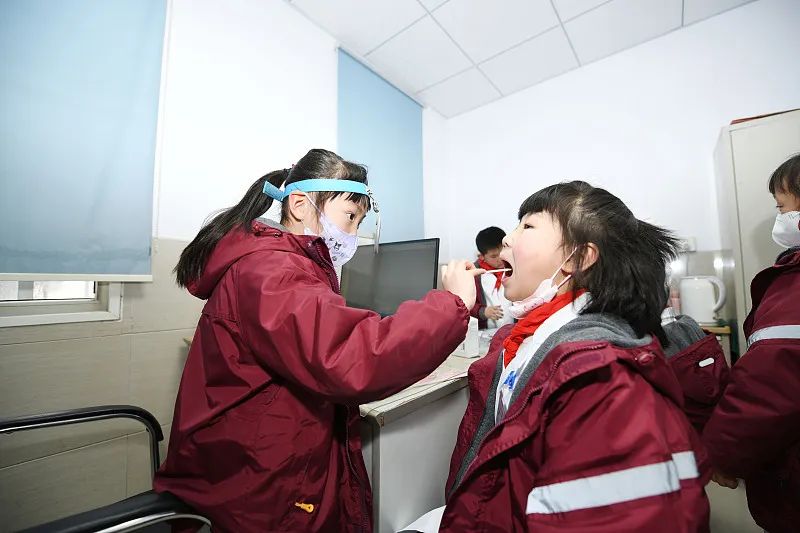 January 22, 2024, Hefei, elementary school students experience being a professional doctor. Image provided by Visual China
January 22, 2024, Hefei, elementary school students experience being a professional doctor. Image provided by Visual China
Author | Tian Yu
Editor | Yang Jie
Due to an ankle sprain, I have visited numerous hospitals over the past six months, including community hospitals, first-level specialty hospitals, well-known tertiary hospitals, and private specialty hospitals. I have seen nine different doctors across various departments, including orthopedics, sports medicine, and pain rehabilitation.
Hospitals are fascinating places; when you are inside, it feels like the biggest world; once you step outside, it seems like just an insignificant corner, a congested road, a landmark that has a name but no substance.
In most cases, hospitals are not pleasant places. Sometimes, the level of discomfort correlates with the size of the hospital. At a tertiary hospital I visited, aside from the elevator attendant, almost no one had a friendly demeanor. The registration slip had a QR code and a barcode; I had to scan it at the triage desk. After scanning the QR code, a nurse suddenly shouted angrily, “Didn’t you see it was supposed to scan the barcode?” Sometimes, even asking for directions could trigger the nurse’s annoyance. Large hospitals feel like a maze; you take one step at a time, and if you go the wrong way, it’s hard to turn back. Someone on social media angrily complained, “You get scolded for asking anything in the hospital, and if you don’t ask and make a mistake, you get scolded again.”
In regular outpatient clinics, there are relatively fewer patients, and doctors are more relaxed. Young doctors examine patients cautiously, speaking slowly and seriously, even trying to comfort patients, saying, “Injuries can easily make you feel down; it will get better slowly.” After leaving, I felt much better. Later, an expert at the hospital determined that I needed surgical treatment. This expert’s appointments were highly sought after; I managed to get one by arriving as soon as the hospital opened. The consultation room wasn’t even open yet, but the entrance was already crowded with people—those pushing wheelchairs, using crutches, or dragging suitcases—many were tightly packed in the one square meter at the door, looking for a chance to squeeze into the consultation room to request an extra appointment. When the doctor arrived, a crowd surged forward, and the doctor looked displeased, I heard him say to his assistant, patients, or perhaps to himself, “I’m not taking extra appointments today.”
From the doctor’s perspective, I can understand this predicament. In such a popular consultation room, taking extra appointments sometimes means that the morning outpatient doctor has to see patients until two or three in the afternoon without eating, drinking, or using the restroom. A friend who works in a hospital once said that every day, they see diseases, pain, and anxiety, and over time, it affects their mood. The medical declaration of “sometimes healing, often helping, always comforting” is often difficult to achieve with such a large and crowded patient base. I once encountered a gentle phlebotomist who, while cleaning with alcohol, said to me, “It won’t hurt, it won’t hurt.” After drawing blood, she carefully helped me hold the form with my other drooping hand, saying the wound needed to be “pressed with three fingers.” That day, after being scolded by so many people in the hospital, I was almost moved to tears. I looked around the crowded hall and then at the assembly line of blood drawing stations, curious about what kind of person could do such a job and still have that kind of patience.
In the hospital, the vast information gap turned me into a first-grade student; a casual comment from a doctor could occupy my thoughts for days, so I always prepared my questions carefully before consultations. On social media, some doctors express their dislike for certain types of patients, including those who “Google their symptoms, are overly anxious, or ask too many questions.” With the rise of online consultations and social media, such patients are becoming more common, and doctors feel increasingly “not trusted.” I might be one of those “too many questions” patients, but for me, asking questions is a form of trust.
I opened a TV series that aired in 2014 called “Obstetrician,” the plot was melodramatic, but I watched it from start to finish. The female lead in the show said, “What is the most important thing for a doctor? It is to gain the trust of the patient.” I felt a bit dazed; trust is so difficult to cultivate between strangers.
My sister studies public health management, and we used to complain together that in our small hometown, when our parents went to see a doctor, they always had to find a connection or ask someone they knew for a recommendation. Now I understand. The cold medical system creates a natural anxiety and fear. We previously didn’t understand why our parents always felt that “the doctors at a small clinic or hospital at home are better than those in big cities”; after six months of consultations, I understand. Sometimes, they might just want to find a trusted doctor to chat with. In a sense, injuries and illnesses are secrets known only to the doctor and the patient; if you can’t talk to the doctor, who else can you talk to?
I worked for a while in the rehabilitation department of a community hospital, where the doctor was gentle and patient. She was familiar with the elderly and patients there; although she was busy, she would still apologize to an elderly lady lying on the treatment bed for being a minute late. During that time, going to the community hospital for therapy became the thing I looked forward to the most because “there wasn’t so much pressure,” and for the first time, I felt that the doctor was listening to me. Later, I went to a first-level specialty hospital, where the doctor told me that the heat therapy I received at the community hospital was ineffective and even counterproductive. It’s so frustrating; in the process of seeking medical care, comfort and efficiency are always at odds. Patients want the most accurate diagnosis while also wanting to be seen and heard, which is a luxury.
Three days after my ankle sprain, I went to the emergency department of a nearby tertiary hospital. At that time, my symptoms were mild, and the doctor had me get a CT scan to confirm that the bones were fine, saying it was a minor issue and that I would be able to walk in two weeks. I happily went home. Two weeks later, I walked quite a bit. Later, the sports medicine doctor told me that since I hadn’t had a cast, I missed the immobilization period, and the ligaments wouldn’t heal properly, requiring surgery. I have complained countless times in my mind about that emergency orthopedic doctor, thinking back to how much simpler it would have been if he had advised me to secure better immobilization at that time.
Two weeks ago, I returned to that hospital to obtain the emergency medical records I needed. I navigated from the triage desk to the consultation room, from the consultation room to the ward, and from the ward to the doctor’s office. When I knocked on the door and went in, I saw the doctor without a mask for the first time; he was very young, enthusiastic, humble, and a bit shy. He helped me retrieve my medical records from months ago and taught me how to print them. Suddenly, I felt that he was just an ordinary person. I couldn’t say anything, and in the end, I just said to him, “Thank you!”
– END –Produced by China Youth Daily · China Youth Network

